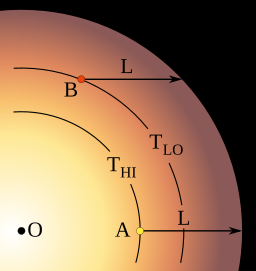Limb darkening

Limb darkening is an optical effect seen in stars (including the Sun), where the center part of the disk appears brighter than the edge or limb of the image. Its understanding offered early solar astronomers an opportunity to construct models with such gradients. This encouraged the development of the theory of radiative transfer.
Basic theory

Crucial to understanding limb darkening is the idea of optical depth. A distance equal to one optical depth is the thickness of the absorbing gas from which a fraction of 1/e photons can escape. This is what defines the visible edge of a star, since it is at a few optical depths that the star becomes opaque. The radiation reaching us is closely approximated by the sum of all the emission along the entire line of sight, up to that point where the optical depth is unity. In particular, if the intensity of radiation in the star varies linearly with optical depth, then the radiation reaching us will be of the intensity at an optical depth of unity. When we look near the edge of a star, we cannot "see" to the same depth as when we look at the center because the line of sight must travel at an oblique angle through the stellar gas when looking near the limb. In other words, the star radius at which we see the optical depth as being unity increases as we move our line of sight towards the limb.
The second effect is the fact that the effective temperature of the stellar atmosphere is (usually) decreasing for an increasing distance from the center of the star. The radiation emitted from a gas is a strong function of temperature. For a black body, for example, the spectrally integrated intensity is proportional to the fourth power of the temperature (Stefan–Boltzmann law). Since when we look at a star, at first approximation, the radiation comes from the point at which the optical depth is unity, and that point is deeper in when looking at the center, the temperature will be higher, and the intensity will be greater, than when we look at the limb.
In fact, the temperature in the atmosphere of a star does not always decrease with increasing height, and for certain spectral lines, the optical depth is unity in a region of increasing temperature. In this case we see the phenomenon of "limb brightening"; for the Sun the existence of a temperature minimum region means that limb brightening should start to dominate at far-infrared or radio wavelengths. Outside the lower atmosphere, and well above the temperature-minimum region, we find the million-kelvin solar corona. For most wavelengths this region is optically thin, i.e. has small optical depth, and must therefore be limb-brightened if spherically symmetric.
Further complication comes from the existence of rough (three-dimensional) structure. The classical analysis of stellar limb darkening, as described below, assumes the existence of a smooth hydrostatic equilibrium, and at some level of precision this assumption must fail (most obviously in sunspots and faculae, but generally everywhere). Instead, the boundary between the chromosphere and the corona consists of a very complicated transition region, best observed at ultraviolet wavelengths only detectable from space.
Calculation of limb darkening

In the figure shown here, as long as the observer at point P is outside the stellar atmosphere, the intensity seen in the direction θ will be a function only of the angle of incidence ψ. This is most conveniently approximated as a polynomial in cos ψ:
where I(ψ) is the intensity seen at P along a line of sight forming angle ψ with respect to the stellar radius, and I(0) is the central intensity. In order that the ratio be unity for ψ = 0, we must have
For example, for a Lambertian radiator (no limb darkening) we will have all ak = 0 except a0 = 1. As another example, for the sun at 550 nm, the limb darkening is well expressed by N = 2 and
(See Cox, 2000). The equation for limb darkening is sometimes more conveniently written as
which now has N independent coefficients rather than N + 1 coefficients that must sum to unity.
The ak constants can be related to the Ak constants. For N = 2,
For the sun at 550 nm, we then have
This model gives an intensity at the edge of the sun's disk of only 30% of the intensity at the centre of the disk.
We can convert these formulas to functions of θ by using the substitution
where Ω is the angle from the observer to the limb of the star. For small θ we have
We see that the derivative of cos ψ is infinite at the edge.
The above approximation can be used to derive an analytic expression for the ratio of the mean intensity to the central intensity. The mean intensity Im is the integral of the intensity over the disk of the star divided by the solid angle subtended by the disk:
where dω = sin θ dθ dφ is a solid angle element, and the integrals are over the disk: 0 ≤ φ ≤ 2π and 0 ≤ θ ≤ Ω. We may rewrite this as
Although this equation can be solved analytically, it is rather cumbersome. However, for an observer at infinite distance from the star, can be replaced by , so we have
which gives
For the sun at 550 nm, this says that the average intensity is 80.5% of the intensity at the centre.
References
- Billings, Donald E. (1966). A Guide to the Solar Corona. Academic Press, New York.
- Cox, Arthur N. (ed) (2000). Allen's Astrophysical Quantities (14th ed.). Springer-Verlag, NY. ISBN 0-387-98746-0.
{{cite book}}:|author=has generic name (help) - Milne, E.A. (1921). "Radiative Equilibrium in the Outer Layers of a Star: the Temperature Distribution and the Law of Darkening". MNRAS. 81 (5): 361–375. Bibcode:1921MNRAS..81..361M. doi:10.1093/mnras/81.5.361.
{{cite journal}}: CS1 maint: unflagged free DOI (link) - Minnaert, M. (1930). "On the Continuous Spectrum of the Corona and its Polarisation". Zeitschrift für Astrophysik. 1: 209.
- Neckel, H.; Labs, D. (1994). "Solar Limb Darkening 1986-1990". Solar Physics. 153 (1–2): 91–114. Bibcode:1994SoPh..153...91N. doi:10.1007/BF00712494.
- van de Hulst; H. C. (1950). "The Electron Density of the Solar Corona". Bull. Astron. Inst. Netherlands. 11 (410): 135.
- Mariska, John (1993). The Solar Transition Region. Cambridge University Press, Cambridge. ISBN 0521382610.
- Steiner, O., Photospheric processes and magnetic flux tubes, (2007) [1]


















